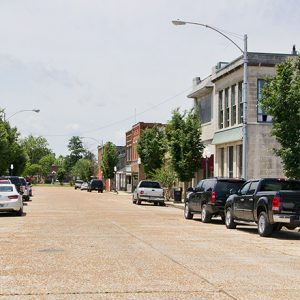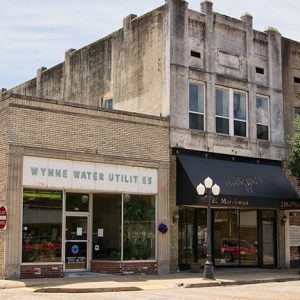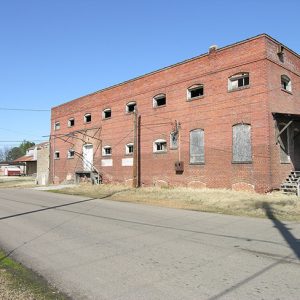calsfoundation@cals.org
Wynne Wholesale Commercial Historic District
The Wynne Wholesale Commercial Historic District is situated around what was considered the most vibrant part of Wynne (Cross County) in the early 1900s. The district consists of five structures—four of which are contributing to the historical significance of the district—and was listed on the National Register of Historic Places on January 25, 2010.
The current building for the Wynne Municipal Waterworks was originally constructed sometime between 1904 and 1908 and altered between 1945 and 1951. The one-story building has a simple rectangular plan with a gabled roof. Two metal vents are centered along the ridge of the roof, and a stepped parapet adorns both the front and back elevations. The building rests on a continuous concrete foundation, and the walls are covered in stucco. On the southern bay is an eight-pane metal casement window; the four-pane transom has been replaced with a louvered vent.
The Wynne Wholesale Grocer Company Building was constructed around 1917 to replace a building that had previously been destroyed by fire. The building—an irregularly shaped, five-sided structure—is a good example of the time period’s architecture. It was constructed to fit on a small lot between Lafayette Avenue (now West Merriman Avenue) and the St. Louis, Iron Mountain and Southern Railroad tracks as they curved northwest toward Bald Knob (White County). The red brick building features common/American bond brickwork; a strong bond was needed because the railroad ran so close to the building. The building has a partially visible basement, and the main floor is about four feet above ground level to accommodate train and truck unloading at the dock areas. The windows feature a segmental arch shape at the top, and the basement and first-story windows each have three rows of headers arranged above them to form a decorative surround.
Built around 1940, the R. J. Gin Company Cotton Gin is the only remaining cotton gin inside Wynne city limits. In the twenty-first century, this building—along with the Wynne Ice & Coal Company—serves as the home to a local construction company. The side-gabled gin is of steel-frame construction and clad in corrugated sheet metal. A shed porch spans the length of the gin’s southern/front elevation, and a cross-gabled porch is situated just to the east of center on this elevation.
Sometime between 1945 and 1951, the Sharp Floral Building was constructed to house a wholesale flower business. The one-story brick building has an L-shaped layout. The main portion of the building has a front-facing gabled roof bounded by a stepped parapet on the front and rear elevations. The building’s front/southern façade features a solid metal door with a single-pane transom window. Just to the west of the door is a large plate-glass window with green glass panes situated above it. The building also features five twenty-eight-pane metal casement windows. In 2010, the building underwent renovations.
Non-contributing to the National Register nomination is the Wynne Ice & Coal Company Ice House, which was constructed about 1930. It was not included in the nomination because the forty-foot-tall building had been shortened to around sixteen feet in the late twentieth century. After the building was shortened, a front-facing gabled metal roof was added. The red brick building has fenestration on the eastern/front elevation. On the building’s southern elevation is a metal shed addition.
The Wynne Wholesale Commercial Historic District remains the most intact and consistent example of Wynne’s early wholesale commercial development near the intersection of the north-south and east-west branches of the St. Louis, Iron Mountain and Southern Railroad. The development of the district reflected the importance of having a thriving commercial area around transportation ways. Even though Wynne’s commercial district has moved closer to the highway to attract people passing through, the Union Pacific Railroad still passes through, serving as a reminder of the days when commerce revolved around the railroad.
For additional information:
“Wynne Wholesale Commercial Historic District.” National Register of Historic Places Nomination form. On file at Arkansas Historic Preservation Program, Little Rock, Arkansas. Online at http://www.arkansaspreservation.com/National-Register-Listings/PDF/CS0055.nr.pdf (accessed October 18, 2021).
Courtney Bradford
Little Rock, Arkansas
 Early Twentieth Century, 1901 through 1940
Early Twentieth Century, 1901 through 1940 Historic Preservation
Historic Preservation Wynne Historic District
Wynne Historic District  Wynne Municipal Waterworks
Wynne Municipal Waterworks  Wynne Wholesale Commercial Historic District
Wynne Wholesale Commercial Historic District 



Comments
No comments on this entry yet.